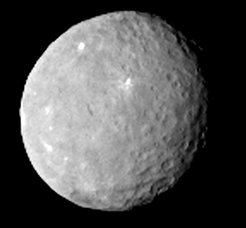Ceres: A steep slope and a crater with a ray system
New images of the dwarf planet show an impressive range of different surface structures.
Crater with a ray system

Only about 55,000 kilometers still separate NASA's Dawn spacecraft from its target, the dwarf planet Ceres. Recent images obtained on 12 February 2015 from a distance of approximately 80000 kilometers now for the first time display the one side of the dwarf planet that Dawn had not before imaged. As can be seen in this picture, this side exhibits an impressive array of surface structures. In addition to deep craters covering entire surface, a semi-circular slope-like feature extends over about 250 kilometers in the right half of the image.
Equally striking is a large, bright crater in the northern hemisphere clearly standing out from its surroundings. The image hints at a ray system encircling this crater: linear, bright structures that extend radially outward from the center of the crater. Similar formations occur around relatively young craters on the Moon and Mars. On these bodies, the bright rays consist of indigenous material that was ejected by an impact. It is still unclear whether in the case of Ceres a similar interpretation applies. It is also conceivable that an impact brought the brighter material to Ceres.
Bright spots

As do earlier images, this view of Ceres shows several bright spots on the dwarf planet’s surface. The picture was taken by the scientific camera system on board the Dawn spacecraft on 12 February 2015 from a distance of approximately 80000 kilometers.
Since the Sun was positioned behind the spacecraft slightly to the left, only the craters on the right side throw distinct shadows. The structures in the middle and on the left side are significantly more difficult to discern. Overall, however, the observations of the past weeks suggest that almost the entire surface of the dwarf planet is covered with craters.
The Dawn mission to Vesta and Ceres is managed by NASA’s Jet Propulsion Laboratory for NASA's Science Mission Directorate (SMD), Washington. It is a project of the Discovery Program, managed for SMD by NASA's Marshall Space Flight Center, Huntsville, Ala. The University of California, Los Angeles, is responsible for overall Dawn mission science. Orbital Sciences Corporation of Dulles, Va., designed and built the Dawn spacecraft. The framing cameras have been developed and built under the leadership of the Max Planck Institute for Solar System Research, Göttingen, Germany, with significant contributions by the German Aerospace Center (DLR) Institute of Planetary Research, Berlin, and in coordination with the Institute of Computer and Communication Network Engineering, Braunschweig. The framing camera project is funded by the Max Planck Society, DLR, and NASA.

